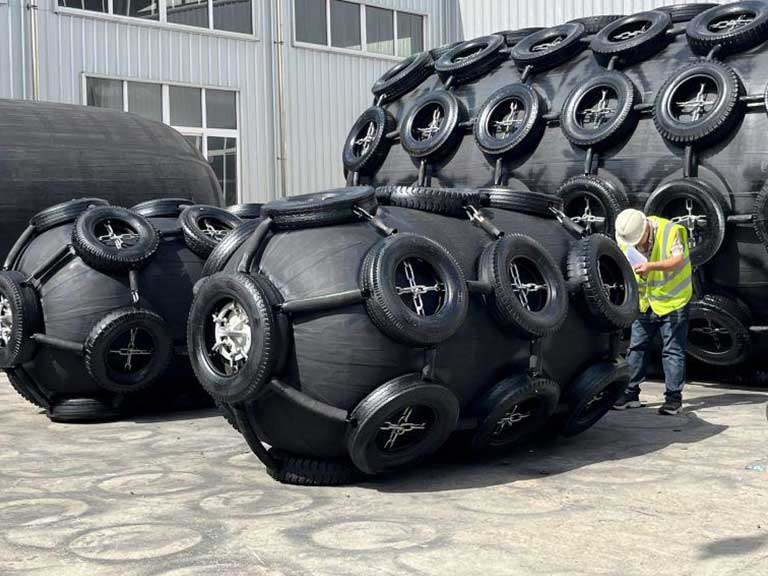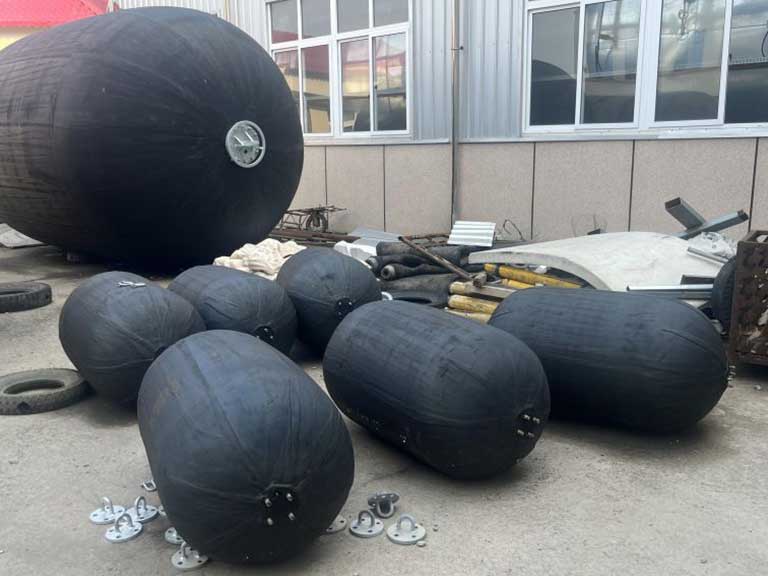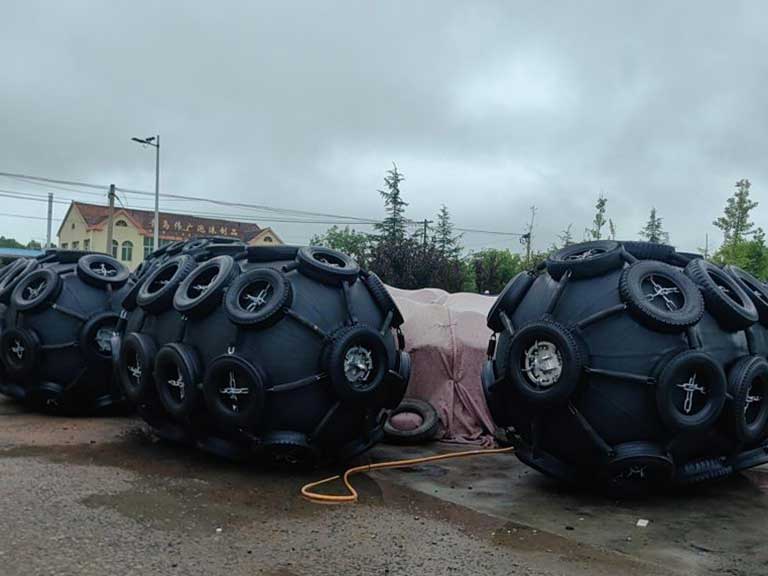There are three primary varieties of pneumatic fenders: chain-tire-net (CTN), sling type, and hydro-pneumatic. CTN fenders are strong and work well in crowded ports. Sling versions are light and good for short-term use. Hydro-pneumatic fenders are a particular type for ships with low freeboards or other special needs, like submarines. All of them are made to absorb kinetic energy as the ship is docking and keep both the ship and the pier safe.
At Henger Shipping Supplies, we manufacture and supply ISO-compliant pneumatic fender tailored for various applications. This guide explores the main types of inflatable fenders and their characteristics. This can help you select the appropriate solution.
Table of Contents
Types of Pneumatic Fenders
Their protective structures and deployment methods categorize pneumatic fenders. The primary types include Chain-Tire-Net, Sling, and Hydropneumatic, each suited to specific scenarios.
| Type | Structure | Energy Absorption (Example) | Weight (for 1.5m Dia.) | Best For | Limitations |
|---|---|---|---|---|---|
| Chain-Tire-Net | Tire net + chains | Up to 500 kNm | 500-800 kg | Harsh STS, permanent berthing | Heavier, slower deployment |
| Sling | Lifting eyes, no net | Up to 300 kNm | 200-400 kg | Temporary, mobile ops | Less abrasion resistance |
| Hydropneumatic | Air-water hybrid | Up to 400 kNm (submerged) | 600-1000 kg (with water) | Submarines, low-pressure | Complex filling, higher cost |

Chain-Tire-Net Type Pneumatic Fenders
Chain-Tire-Net pneumatic fenders have a protective net on the outside constructed of old tires linked by chains. This net surrounds the rubber body that is inflated with air. As per ISO 17357-1:2014 standards, this design has an exterior rubber layer to protect it from the elements, an inside rubber membrane to contain compressed air, and synthetic tire cord layers for extra strength.
The tire net stops direct hits and abrasions, making the tire more durable in tough situations. These fenders float on water due to their air core and can absorb up to 500 kNm of energy for larger models (e.g., 2.0 m diameter), with low reaction forces under 100 kN.
Chain-Tire-Net fenders are widely used in ship-to-ship transfers. They act as a buffer to prevent damage during the maneuvering and docking. They are also great for docking in ports and harbors. And they offer better protection to both the ship and the dock. They absorb high energy and have low reaction force. This makes them suitable for handling large vessels and high-impact scenarios.
Advantages:
- High Durability: The tire net provides additional abrasion resistance, extending service life to 10+ years with proper care.
- Resistance to Harsh Conditions: Withstands extreme marine environments, including waves up to 1.5 m and temperatures from -30°C to 80°C.
- Low Maintenance: Requires minimal upkeep beyond periodic inspections, leading to cost savings over time.
Sling Type Pneumatic Fenders
Sling type pneumatic fenders lack an external tire net and are instead constructed from high-strength rubber. Additionally, they incorporate synthetic tire cord reinforcement material and feature built-in lifting/towing lugs at both ends for ease of handling. They are lightweight and have diameters between 0.5 m and 3.3 m. They are filled with compressed air at 50–80 kPa.
These fenders are common in temporary berthing and ship-to-ship operations. Quick deployment is essential. They are versatile and can be slung using ropes or chains, making them suitable for various maritime applications. People like sling type fenders. They are easy to handle and work well in different conditions.
Differences from Chain-Tire-Net Fenders:
- Structure: Sling type fenders are lighter and easier to handle. Unlike Chain-Tire-Net fenders, they do not have an external tire net.
- Usage: Sling type fenders are good for rapid deployment. Chain-Tire-Net fenders are better for prolonged use in harsh conditions.

Hydropneumatic Fenders
Hydropneumatic fenders are made for supporting vessels. They have low hull pressure, like submarines. Hydropneumatic fenders combine air and water filling (typically 60-70% water for ballast), allowing submersion for low-hull-pressure applications. This lets them sink deeper in the water and provide good fendering below the waterline. The water component adds weight and stability, while the air component provides the cushioning effect.
- Specific Use Cases: Hydropneumatic fenders are mainly used in submarine docking. The vessel’s hull is far below the water surface. These fenders ensure safe docking by absorbing the kinetic energy and reducing impact forces on the submarine’s hull. They are also used for other specialized vessels that require low-pressure fendering solutions.
- Benefits: Provides superior stability below the waterline. However, they are more complex to fill and maintain than pure pneumatic types.
How to Choose the Right Pneumatic Fender?
- Assess Application: STS or berthing? High-impact needs Chain-Tire-Net.
- Evaluate Environment: Harsh weather? Opt for durable netting. Tidal areas? Choose mobile sling types.
- Consider Vessel Type: Submarines require hydropneumatic for low pressure.
- Review Specs: Match size/energy needs (e.g., calculate via formula: Energy = 0.5 mass velocity²).
- Budget and Compliance: Prioritize ISO-certified for long-term value.
For custom advice, contact Henger Shipping Supplies.

Conclusion
Pneumatic fenders are key for keeping vessels safe. They are needed during berthing, docking, and ship-to-ship operations. There are many types of pneumatic fenders. They include Chain-Tire-Net, sling, and hydropneumatic fenders. Knowing them helps in choosing the right one for specific maritime needs. Regular maintenance and following ISO standards also guarantee the reliability and longevity of these fenders.
Henger Shipping Supplies is dedicated to providing high quality pneumatic fenders. They are designed to meet the tough demands of maritime operations. You may need robust Chain-Tire-Net fenders for harsh conditions. Or, versatile sling fenders for quick deployment. Or, specialized hydropneumatic fenders for submarines. We have the expertise and products to keep your vessels safe.
For custom pneumatic fender solutions and expert guidance, contact Henger Shipping Supplies today. Our team is ready to help you choose the best fenders for your needs. They will ensure safety, efficiency, and peace of mind.
FAQ
What are Yokohama Fenders?
Yokohama Fenders are inflatable rubber cushioning devices. Their function is to absorb impact energy during maritime operations such as ship berthing, protecting vessels and port facilities from damage by cushioning collision impacts.
What are the main types of pneumatic fenders?
The main pneumatic fenders include the Chain-Tire-Net Type. It is surrounded by a tire net for extra durability. There is also the Sling Type, which is lightweight with lifting eyes. It is suitable for temporary berthing. Finally, there is the Hydropneumatic type. It is partially filled with water and air and is ideal for submarines.
How do I choose the right pneumatic fender?
Consider the application: ship-to-ship transfer and berthing. Also, consider the environment: harsh weather and tidal variations. Lastly, consider the vessel type: large commercial ships and submarines. Chain-Tire-Net fenders last in harsh conditions. Sling types are easy to deploy. Hydropneumatic fenders are best for delicate vessels.
What maintenance is required for pneumatic fenders?
Regularly inspect for damage or wear, check air pressure levels, and ensure tire nets are intact. Clean to remove salt and marine growth, and store in a cool, dry place when not in use. Consistent maintenance extends fender life and ensures performance.
What is the difference between pneumatic and foam fenders?
Pneumatic fenders use air to absorb energy, offering high impact resistance and flexibility. Foam fenders are made of resilient foam, providing unsinkable protection with low maintenance. Pneumatic fenders are good for changing conditions. Foam fenders are best for consistent, heavy use.




